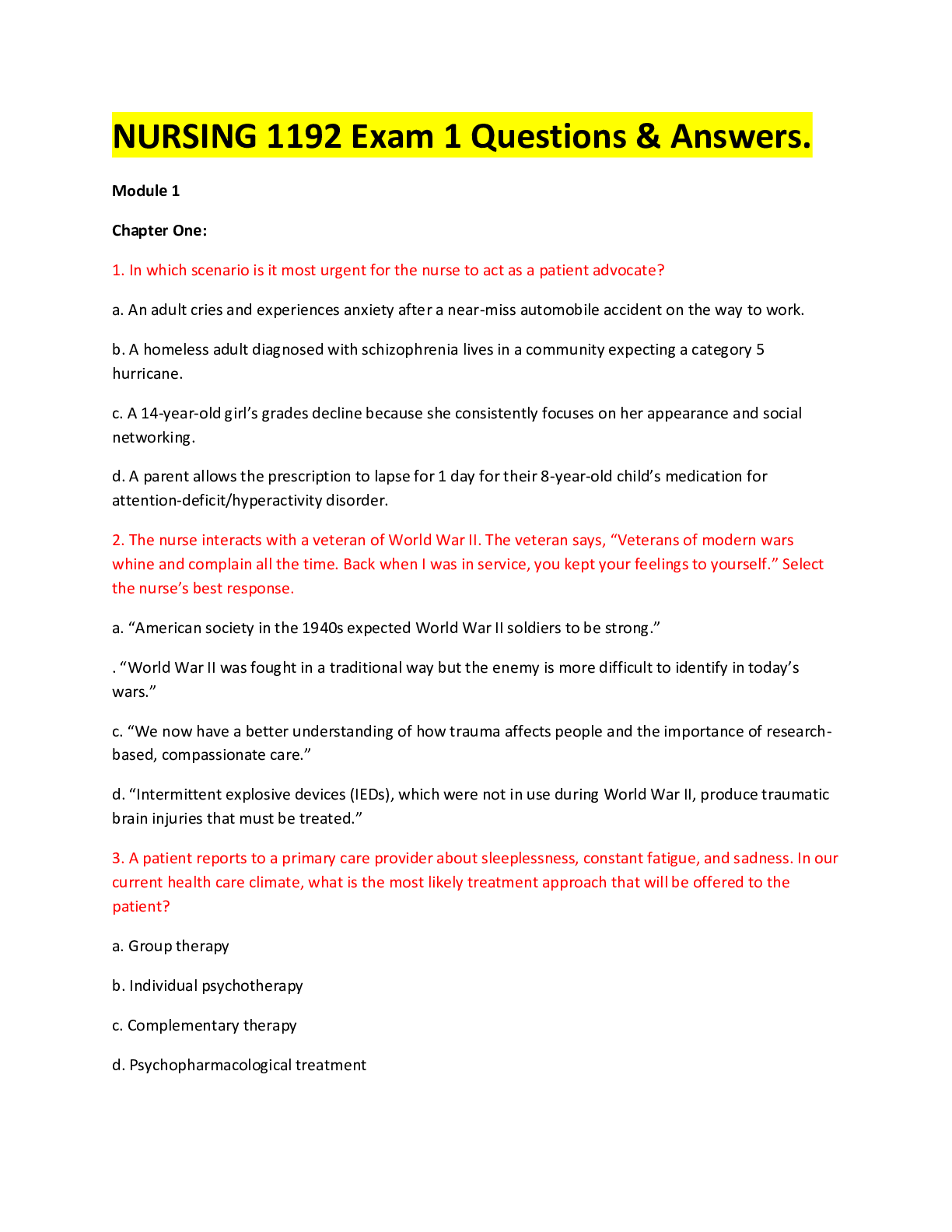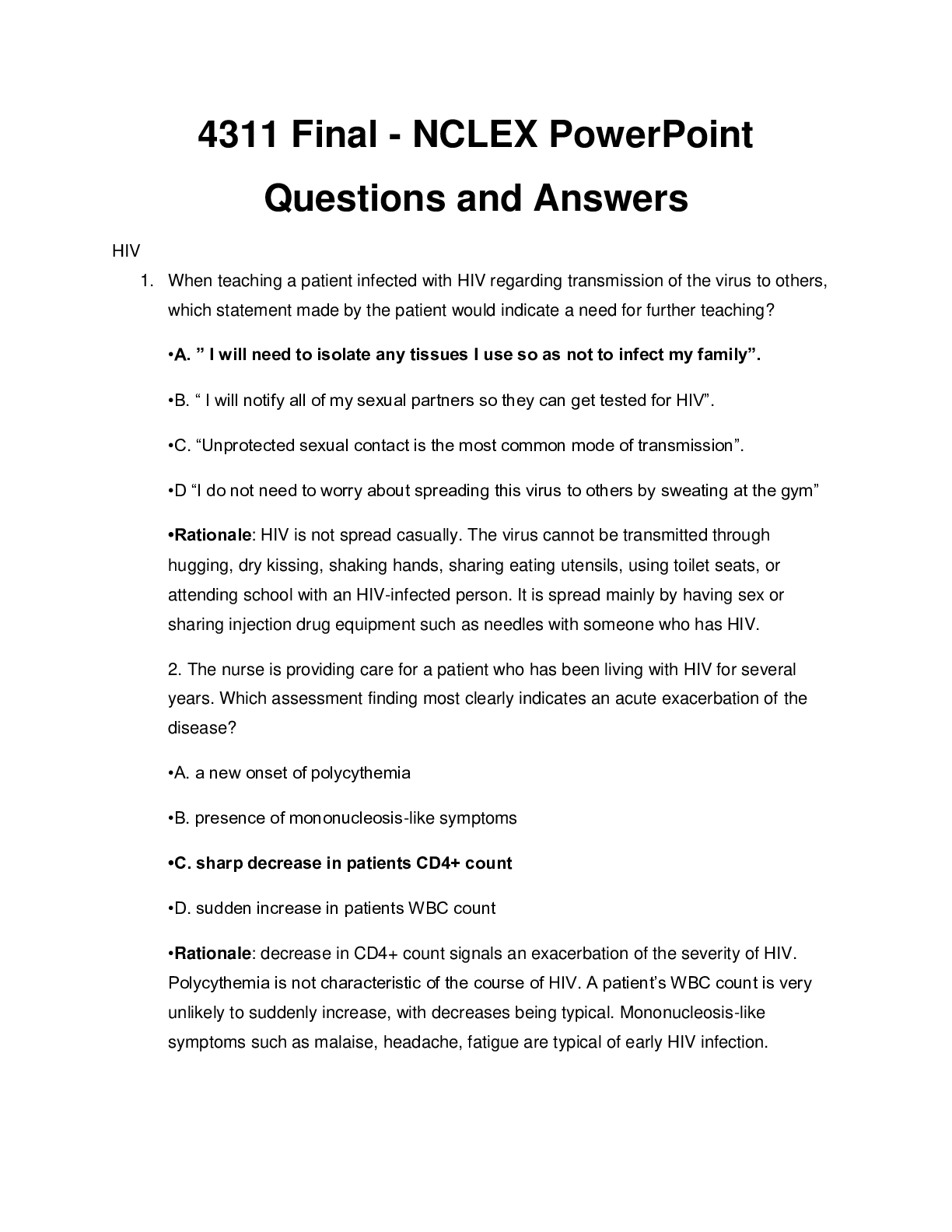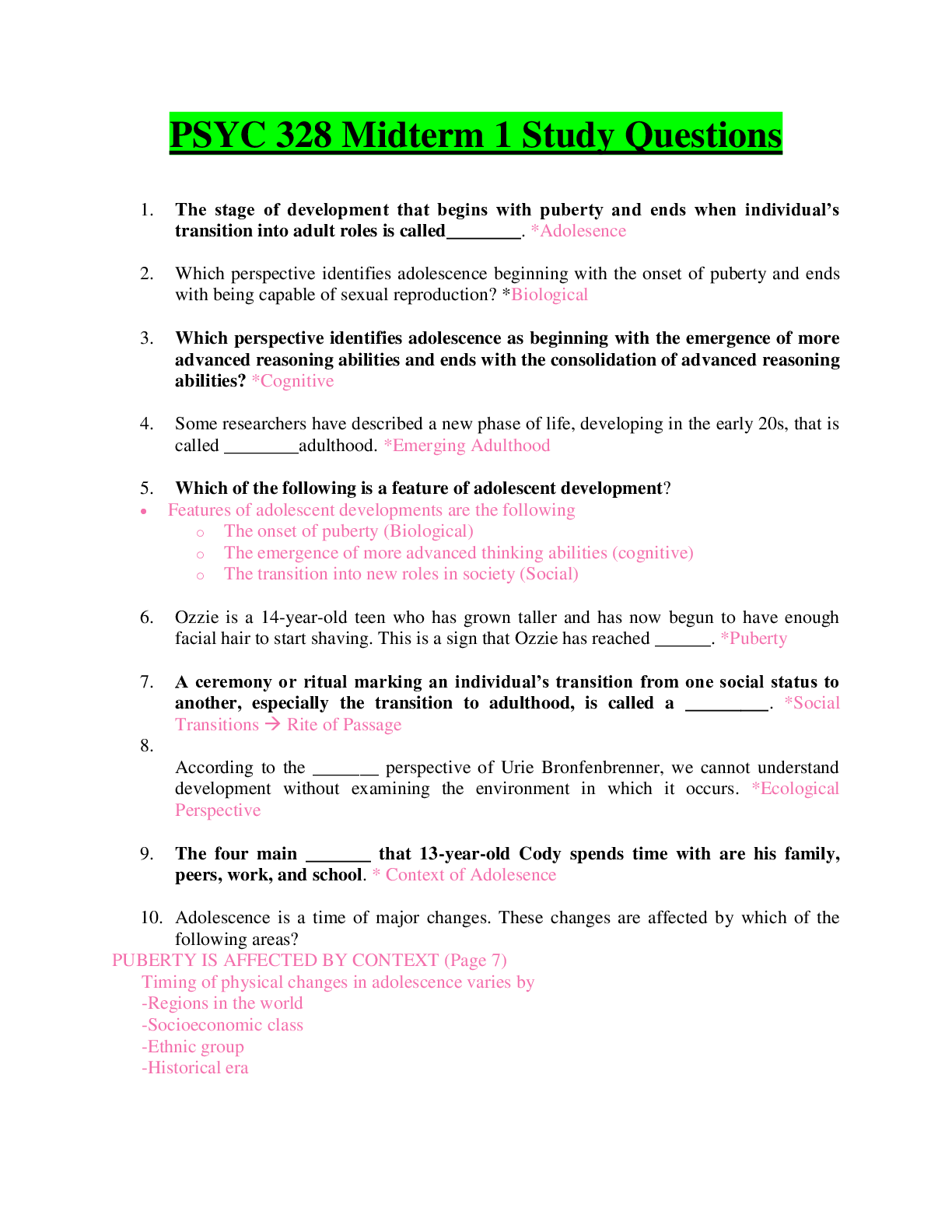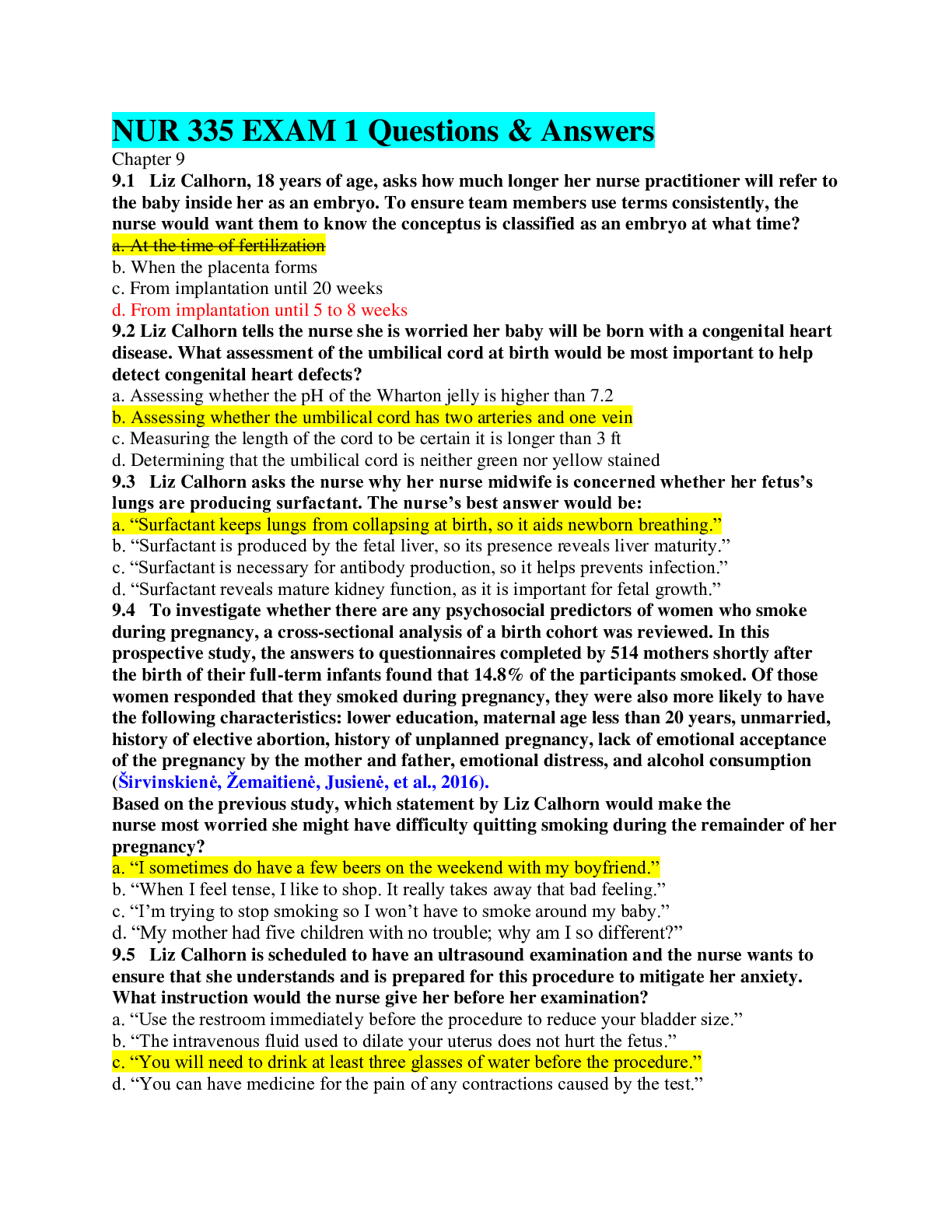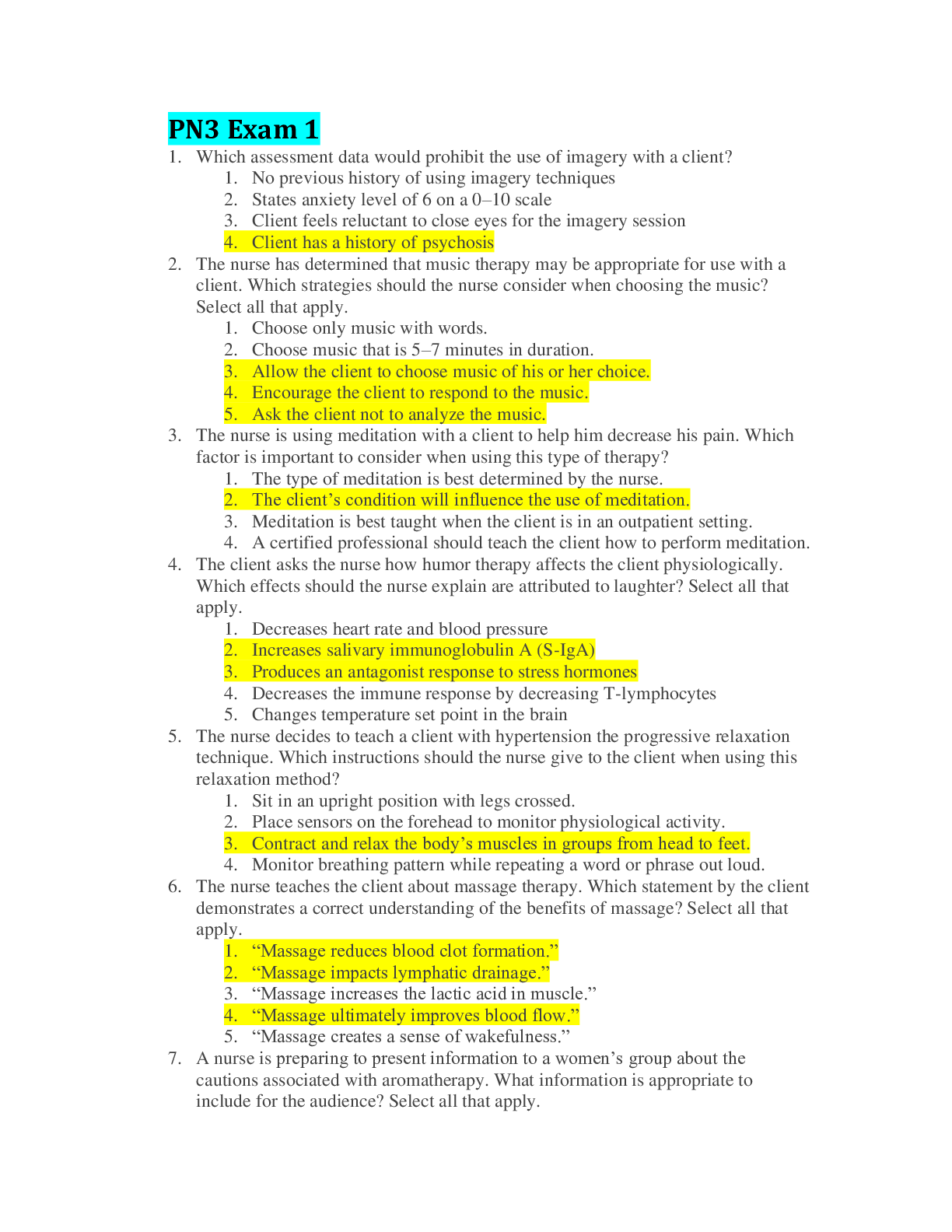*NURSING > QUESTIONS & ANSWERS > MDC 3 Exam 1 Questions and Answers with Complete Solution. Rated A (All)
MDC 3 Exam 1 Questions and Answers with Complete Solution. Rated A
Document Content and Description Below
MDC 3 Exam 1 Questions and Answers with Complete Solution What is the 2nd most common malignancy in women and 2nd leading cause of death in women? Correct Answer- Breast cancer How does breast can... cer start? Correct Answer- From the epithelial lining of the ducts or the epithelium of the lobules 99% of breast cancers occur in what gender? Correct Answer- women breast cancer is slightly more common in what race of women? Correct Answer- white breast cancer in men is similar across? Correct Answer- all ethnic groups Risk factors for breast cancer? Correct Answer- -post menopause (increasing in age after 60) -Estrogen (HRT: hormone replacement therapy) (post menopause therapy) can be with progesterone or alone. - History or genetics (history of breast, colon, endometrial, &ovarian cancer, or family history of breast cancer) (*Gene BRCA1 or BRCA2 hold a 5-10% genetic risk) -Alcohol -Childbirth after age 30 -Obesity -Smoking -Breast cellular changes: hyperplasia, atypical appearance (increased risk) Breast cancer signs and symptoms Correct Answer- -lump in breast -swelling -skin irritation -dimpling-breast pain -nipple pain -nipple turning inward -redness -scaliness -thickening of the nipple -unusual discharge -lump in the armpit (more rare but can present itself as an orange peel) *Where is the most common location of breast cancer? * Correct Answer- *upper outer quadrant is the most glandular tissue, as a result it is the most common location of a cancer* Breast cancer screening & diagnostics Correct Answer- -history -physical assessment and examination -mammogram (less effective in younger women due to denser breast tissue) -ultrasound -MRI (gives more details than a mammogram or ultrasound) -Biopsy -Labs -Pathology Breast health large breast challenges Correct Answer- -Impaired comfort -Back pain -diffculty finding clothing that fits -expensive bras -fungal infections under breasts -redness, chaffing or rash, under breasts.Breast health small breast challenges Correct Answer- -some choose breast augmentation (important to avoid foods, medications, herbs that increase bleeding before/after surgery) -Can still perform self examination and have mammograms- but may not be as sensitive -*some evidence of increased risk for non Hodgkins lymphoma Not breast cancer* *Breast Cancer Types* Correct Answer- -*In situ* (non-ivasive) breast cancer remains in the mammary *DCIS: ductal carcinoma in situate* duct or lobules -*ILC: invasive lobular carcinoma* *IDC: invasive ductal carcinoma* *Non-invasive or In situ breast cancer is* Correct Answer- *DCIS: ductal carcinoma is situate* *Invasive breast cancer is* Correct Answer- *ILC or IDC* -the cancer grows into the surrounding tissue and can metastasize -most likely cause of skin dimpling or peau'd orange -Aggressive form : itching, rapidly growing lump, breast pain, erythema & edema *Most common invasive cancer* Correct Answer- *IDC: infiltrating ductal carcinoma* *breast cancer treatment* Correct Answer- -Surgery: breast conserving & masectomy -Radiation therapy -Chemotherapy -Hormone therapy breast conserving surgery Correct Answer- removes the entire tumor along with a margin of normal tissue and may include lymph node removalMasectomy Correct Answer- Total or simple usually involves lymph nodes Radiation therapy Correct Answer- directed therapy to the site of the cancer (original tumor) Chemotherapy Correct Answer- (S/E depends on the drugs used, frequency, and dose) -*IV therapy in 2-3 week cycles over 3-6 months* -Regular blood work is needed Most common chemotherapy drugs 2 or 3 of these drugs mixed usually Correct Answer- -Anthracyclines (doxurubicin & epirubicin) -Taxanes (paclitazel & docetaxel) -Cyclophosphadmide -Carboplatin Typical side effects of chemotherapy Correct Answer- -hair loss -nail changes -mouth sores -loss of appetite -N/V -Diarrhea -Increase risk of infection -Easy bruising or bleeding -Fatigue -Menstrual changes and infertility -"Chemo brain" Lower risk side effects of chemotherapy Correct Answer- -heart damage -risk of leukemia *-hand foot syndrome (numb, tingling, red, swollen hands & soles)*-Nerve damage Hormone therapy cancer treatment options Correct Answer- -many block estrogen receptors -SERM: selective estrogen modulators: tamoxifen, toremifene, fulverstrant. -AI: artomatase inhibitors: prevent production of estrogen: anastrozole, letrozole, exemestane. Breast Cancer Prognosis Correct Answer- -tumor size -nodal involvement -tumor differentiation -estrogen & progesterone receptor status -*HER-2 Status: human epidermal growth factor receptor 2* Survival breast cancer rates Correct Answer- -Localized breast cancer: 99% -Spread to regional lymph nodes: 85% -Metastic breast cancer: 27% Benign (non cancer) breast issues: Correct Answer- -Fibroadenoma -Fibrocystic breast condition Fibroadenoma Correct Answer- -benign but does hold a *slightly increase risk for breast cancer* -tumors are oval, freely mobile, rubbery, and vary in size. -If cystic: will usually be monitored -If solid: will usually be removed Fibrocystic breast condition Correct Answer- -*Not a risk factor for breast cancer* -changes to lobules, ducts, & stromal tissues of the rbeast -Thought to be caused by an imbalance in normal estrogen/ progesterone ratio -S/E: pain, tenderness, swelling before menstruation. -Treatment: diuretics to reduce swelling, analgesics for pain, SERM, oral contraceptivesAssessment details Correct Answer- -patient history -nutrition history -personal/familyhistory -co-morbid issues -history of presenting condition -physical exam (breast, abdomen, pelvis, genitals) -psychosocial assessment -diagnostic (labs usually hormone levels) Breast cancer nursing interventions Correct Answer- -pain management -diet support -comfort -drug therapy -support groups -symptom management -education -links to resources -depression/ anxiety screening -surgery prep -post surgery care -involve client in care planning -*ARM health: functional restoration, precautions, supported with pillow, excercises, PT/OT if appropriate, not dependent for long periods of time, use other arm to carry bags, hygeine habits* Uterine Leiomyoma Correct Answer- -Uterine fibroids -Benign uterine growth in the myometrium (smooth muscle) classified by locaiton -Most common benign tumors in women-3 types: *Intramural* (in uterine wall), *Submucosal*(protrudes into the cavity of the uterus can cause bleeding/disrupt pregnancy), *Subserosal* (protrudes through the other surface, can press against other organs) Uterine Leiomyoma signs and symptoms Correct Answer- -bleeding, pain, symptoms associated with pelvic pressure Uterine Leiomyoma Treatment options Correct Answer- -Non-ivasive: monitor, oral contraceptives (most common treatment), magnetic resonance guided focused ultrasound surgery, uterine arter embolization. -Surgery: laparoscopic myomectomy, hysterectomy Uterine Prolapse Correct Answer- uterine herniation into the vagina Uterine prolapse S/S Correct Answer- -feeling pelvic pressure -dyspareunia (painful intercourse) -Stress urinary incontinence -Urinary elimination issues -Rectocele (hemorrhoids, constipation, fecal impactation) Uterine Prolapse treatment Correct Answer- -Nothing -Kegal excercises -pessary (prosthetic device) -Surgery: surgical vaginal mesh, >anterior colporrhaphy >posterior colporrhaphy. anterior colporrhaphy Correct Answer- tightens pelvic muscles for better bladder support, splint abdomen, limit physical activity, weight rest 5lbs, no sex for 6 weeks.posterior colporrhaphy Correct Answer- reduces rectal bulging, low residue (fiber) diet to decrease bowel movements, avoid straining, sitz baths pain management to aid in fecal elimination. Endometrial Cancer Correct Answer- -Most common gynecologic malignancy -usually slow growing -if diagnosed early 95% survival rate S/S of endometrial (uterine) cancer Correct Answer- -abnormal uterine bleeding, especially in post menopausal women -pain during urination -pain during intercourse Endometrial cancer diagnostic Correct Answer- *-endometrial biopsy: gold standard* Treatment for endometrial (uterine) cancer Correct Answer- -Total hysterectomy -radiation -chemotherapy -hormonal therapy Cervical Cancer is known as Correct Answer- "silent killer" generally asymptomatic in early stages How to detect cervical cancer early? Correct Answer- pap smear Late stage symptoms of cervical cancer Correct Answer- vaginal discharge that becomes dark and foul smelling, vaginal bleeding becomes heavier, pain, weight loss, anemia, *cachexia: wasting syndrome (weight and muscle loss)* Cervical Cancer diagnosis Correct Answer- -pap smear -colonoscopy -biopsyTreatment for cervical cancer Correct Answer- -prevention (HPV vaccine) -Surgery -Chemotherapy -Hormone therapy -Radiation Surgeries for Cervical Cancer Correct Answer- -hysterectomy: removal of uterus and cervix -Vulvectomy: remove part or all of the vulva -Myomectomy: removal of fibroids from the uterus -Vaginectomy: removal of vagina Cervical Cancer is usually seen in _____ and endometrial cancer is usually seen in ____ Correct Answerwomen in reproductive years Girls & young women Ovarian Cancer Correct Answer- *leading cause of death for reproductive cancers* -epithelial tumors grow on the surface of the ovaries Risk factors for ovarian cancer Correct Answer- -over 40 -personal or family history of ovarian or breast cancer -diabetes -*Nulliparity (or first child after 30)* -Infertility -Early menarche/ late menopause -Endometriosis -Obesity or high fat dietOvarian Cancer signs/ symptoms Correct Answer- -mild or vague symptoms: nausea, indigestion, gas -abdominal pain/ swelling -Late stage: ascites, pleural effusions, lymphedema, intestinal obstruction, malnutrition Diagnosis of Ovarian cancer: Correct Answer- -dependent on yearly pelvic examinations -Can use screening tumor marker *CA-125* but it is non specific so it could be an indicator or endometriosis, fibroid, or other benign conditions. Toxic shock Correct Answer- overstimulation of immune responses by bacterial exotoxins in the blood (can be caused by tampons) PCOS Correct Answer- polycystic ovarian syndrome MODULE 2 Correct Answer- MODULE 2 BPH (benign prostatic hyperplasia) Correct Answer- When a male ages testosterone levels are decreased and normal estrogen levels increase which increases the activity of dihydroxytestosterone leading to cell growth (prostate growth), growth then usually compresses the urethra leading to partial or complete obstruction prostate Correct Answer- it is a walnut shaped gland of the male reproductive system that is responsible for production of the fluid component of semen. It surrounds the urethra at the neck of bladder in front of the rectum (had 2 or more lobes/sections) Occurrence of BPH Correct Answer- Affects approx 50% of men between 51-60 years old effects up to 90% of men older than 80 *medications that increase the risk of acute urinary retention in the presence of BPH * Correct Answer- *decongestants, antihistamines impact the functioning of the muscles bladder making it difficulty to release the urine*BPH risk factors Correct Answer- -age -obesity -sedentary life -alcohol -erectile dysfunction -smoking -diabetes -1st degree relative Screening & diagnostics for BPH Correct Answer- -physical exam -medical tests -personal & family history Potential complications of BPH Correct Answer- -retention -uti -calculi in the bladder -*hydronephrosis or pyelonephritis can lead to renal failure* Treatment for BPH? Correct Answer- -dietary changes (decreasing caffeine & alcohol) -avoid decongestant and anticholinergic medications -minimally invasive procedures -Surgery TURP & TUIP -Medications: alpha blockers, PD5 inhibitors, 5-alpha reductase inhibitors, combination. Minimally invasive procedures that can relieve symptoms and destroy enlarged prostate tissue and widen the urethra? Correct Answer- -Transureth [Show More]
Last updated: 2 years ago
Preview 1 out of 24 pages

Buy this document to get the full access instantly
Instant Download Access after purchase
Buy NowInstant download
We Accept:

Reviews( 0 )
$9.00
Can't find what you want? Try our AI powered Search
Document information
Connected school, study & course
About the document
Uploaded On
Sep 14, 2022
Number of pages
24
Written in
Seller

Reviews Received
Additional information
This document has been written for:
Uploaded
Sep 14, 2022
Downloads
0
Views
118













